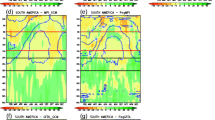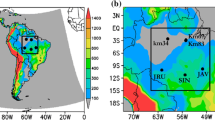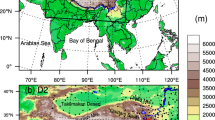Abstract
Coupling of the Community Land Model (CLM3) to the ICTP Regional Climate Model (RegCM3) substantially improves the simulation of mean climate over West Africa relative to an older version of RegCM3 coupled to the Biosphere Atmosphere Transfer Scheme (BATS). Two 10-year simulations (1992–2001) show that the seasonal timing and magnitude of mean monsoon precipitation more closely match observations when the new land surface scheme is implemented. Specifically, RegCM3–CLM3 improves the timing of the monsoon advance and retreat across the Guinean Coast, and reduces a positive precipitation bias in the Sahel and Northern Africa. As a result, simulated temperatures are higher, thereby reducing the negative temperature bias found in the Guinean Coast and Sahel in RegCM3–BATS. In the RegCM3–BATS simulation, warmer temperatures in northern latitudes and wetter soils near the coast create excessively strong temperature and moist static energy gradients, which shifts the African Easterly Jet further north than observed. In the RegCM3–CLM3 simulation, the migration and position of the African Easterly Jet more closely match reanalysis winds. This improvement is triggered by drier soil conditions in the RegCM3–CLM3 simulation and an increase in evapotranspiration per unit precipitation. These results indicate that atmosphere–land surface coupling has the ability to impact regional-scale circulation and precipitation in regions exhibiting strong hydroclimatic gradients.




















Similar content being viewed by others
References
Abiodun BJ, Pal JS, Afiesimama EA, Gutowski WJ, Adedoyin A (2008) Simulation of the West African monsoon using RegCM3, Part II: impacts of deforestation and desertification. Theor Appl Climatol 93:245–261. doi:10.1007/s00704-007-0333-1
Afiesimama EA, Pal JS, Abiodun BJ, Gutowski WJ Jr, Adedoyin A (2006) Simulation of West African monsoon using the RegCM3. Part I: model validation and interannual variability. Theor Appl Climatol 86:23–37. doi:10.1007/s00704-005-0202-8
Betts AK, Ball JH (1995) The FIFE surface diurnal cycle climate. J Geophys Res 100:25679–25693. doi:10.1029/94JD03121
Betts AK, Ball JH, Beljaars ACM, Miller MJ, Viterbo PA (1996) The land-surface interaction: a review based on observational and global modeling perspectives. J Geophys Res 101:7209–7225. doi:10.1029/95JD02135
Bonan GB, Levis S, Kergoat L, Oleson KW (2002) Landscape as patches of plant functional types: an integrating concept for climate and ecosystem models. Global Biogeochem Cycles 16:2. doi:10.1029/2000GB001360
Boone A, deRosnay P (2007) Towards the improved understanding of land-surface processes and coupling with the atmosphere over West Africa. iLEAPS Newl 3:33–34
Burpee RW (1972) The origin and structure of easterly waves in the lower troposphere. J Atmos Sci 29:77–90. doi:10.1175/1520-0469(1972)029<0077:TOASOE>2.0.CO;2
Charney JG, Quirk WJ, Chow S, Kornfield J (1977) A comparative study of the effects of albedo change on droughts in semi-arid regions. J Atmos Sci 34:1366–1385. doi:10.1175/1520-0469(1977)034<1366:ACSOTE>2.0.CO;2
Chou C, Neelin JD (2003) Mechanisms limiting the northward extent of the northern summer convection zones. J Clim 16:406–425. doi:10.1175/1520-0442(2003)016<0406:MLTNEO>2.0.CO;2
Cook KH (1999) Generation of the African Easterly Jet and its role in determining West African precipitation. J Clim 12:1165–1184. doi:10.1175/1520-0442(1999)012<1165:GOTAEJ>2.0.CO;2
Cook KH, Vizy EK (2006) Coupled model simulations of the West African Monsoon System: twentieth and twenty-first-century simulations. J Clim 19(15):3681–3703. doi:10.1175/JCLI3814.1
Cosgrove BA et al (2003) Land surface model spin-up behavior in the North American Land Data Assimilation System (NLDAS). J Geophys Res 108(22):8845. doi:10.1029/2002JD003316
Dai Y-J et al (2003) The common land model. Bull Am Meteorol Soc 84(8):1013–1023. doi:10.1175/BAMS-84-8-1013
de Goncalves LGG, Shuttleworth WJ, Burke EJ, Houser P, Toll DL, Rodell M, Arsenault K (2006) Toward a South America Land Data Assimilation System: aspects of land surface model spin-up using the simplified simple biosphere. J Geophys Res 111:D17110. doi:10.1029/2005JD006297
Dickinson R, Henderson-Sellers A, Kennedy P (1993) Biosphere-atmosphere transfer scheme (BATS) version 1e as coupled to the NCAR community climate model. Technical report, National Center for Atmospheric Research
Dickinson RE et al (2006) The community land model and its climate statistics as a component of the community climate system mode. J Clim 19:2302–2324. doi:10.1175/JCLI3742.1
Diedhiou A, Mahfouf J-F (1996) Comparative influence of land and sea surfaces on the Sahelian drought: a numerical study. Ann Geophys 14:115–130. doi:10.1007/s00585-996-0115-6
Dirmeyer PA, Gao X, Zhao M, Guo Z, Oki T, Hanasaki N (2006) GSWP-2: multi-model analysis and implications for our perception of the land surface. Bull Am Meteorol Soc 87:1381–1397. doi:10.1175/BAMS-87-10-1381
Douville H, Conil S, Tyteca S, Voldoire A (2007) Soil moisture memory and West African monsoon predictability: artefact or reality? Clim Dyn 28(7–8):723–742. doi:10.1007/s00382-006-0207-8
Eltahir EAB, Gong C (1996) Dynamics of wet and dry years in West Africa. J Clim 9(5):1030–1042. doi:10.1175/1520-0442(1996)009<1030:DOWADY>2.0.CO;2
Emanuel KA (1991) A scheme for representing cumulus convection in large-scale models. Q J R Meteorol Soc 48:2313–2335
Emanuel KA (1995) On thermally direct circulations in moist atmosphere. J Atmos Sci 52(9):1529–1533. doi:10.1175/1520-0469(1995)052<1529:OTDCIM>2.0.CO;2
FAO/UNESCO (1974) Soil Map of the World. Volume I: legend. UNESCO, Paris, France
Fontaine, B, Philippon N, Trzaska S, Roucou P (2002) Spring to summer changes in the West African monsoon through NCEP/NCAR reanalyses (1968–1998). J Geophys Res 107:D14, 4186. doi:10.1029/2001JD000834
Fontaine B, Louvet S, Roucou P (2007) Fluctuations in annual cycles and interseasonal memory in West Africa: rainfall, soil moisture and heat fluxes. Theor Appl Climatol 88:57–70. doi:10.1007/s00704-006-0246-4
Gallée H et al (2004) A high-resolution simulation of a West African rainy season using a regional climate model. J Geophys Res D05108. doi:10.1029/2003JD004020
Giannini A, Saravanan R, Chang P (2003) Oceanic forcing of Sahel rainfall on interannual to interdecadal time scales. Science 302:1029–1030. doi:10.1126/science.1089357
Giorgi F, Bates G (1989) The climatologic al skill of a regional model over complex terrain. Mon Weather Rev 117:2325–2347. doi:10.1175/1520-0493(1989)117<2325:TCSOAR>2.0.CO;2
Giorgi F, Bates G, Nieman S (1993) The multi-year surface climatology of a regional atmospheric model over the western United States. J Clim 6:75–95. doi:10.1175/1520-0442(1993)006<0075:TMSCOA>2.0.CO;2
Giorgi F, Pal JS, Bi X, Sloan L, Elguindi N, Solmon F (2006) Introduction to the TAC special issue: the RegCNET network. Theor Appl Climatol 86:1–4. doi:10.1007/s00704-005-0199-z
Global Soil Data Task (2000) Global Soil Data Products CD-ROM (IGBP-DIS). CD-ROM. International Geosphere-Biosphere Programme, Data and Information System, Potsdam, Germany. Available from Oak Ridge National Laboratory Distributed Active Archive Center, Oak Ridge, Tennessee, U.S.A. [http://www.daac.ornl.gov]
Grell GA (1993) Prognostic evaluation of assumptions used by cumulus parameterizations. Mon Weather Rev 121(3):764–787. doi:10.1175/1520-0493(1993)121<0764:PEOAUB>2.0.CO;2
Grell GA, Dudhia J, Stauffer D (1994) A description of the fifth-generation Penn State/NCAR mesoscale model (MM5). Technical report NCAR/TN-398 + STR, National Center for Atmospheric Research
Grist JP, Nicholson SE (2001) A study of the dynamic factors influencing the rainfall variability in the West African Sahel. J Clim 14:1337–1359. doi:10.1175/1520-0442(2001)014<1337:ASOTDF>2.0.CO;2
Holtslag A, de Bruijn E, Pan H-L (1990) A high resolution air mass transformation model for short-range weather forecasting. Mon Weather Rev 118:1561–1575. doi:10.1175/1520-0493(1990)118<1561:AHRAMT>2.0.CO;2
Janicot S, Trzaska S, Poccard I (2001) Summer Sahel-ENSO teleconnection and decadal time scale SST variation. Clim Dyn 18:303–320. doi:10.1007/s003820100172
Joly M et al (2007) African monsoon teleconnections with tropical SSTs: validation and evolution in a set of IPCC4 simulations. Clim Dyn 29:1–20. doi:10.1007/s00382-006-0215-8
Kiehl J, Hack J, Bonan G, Boville B, Breigleb B, Williamson D, Rasch P (1996) Description of the NCAR community climate model (CCM3). Technical report NCAR/TN-420 + STR, National Center for Atmospheric Research
Konaré, A, Zakey A, Solmon F, Giorgi F, Rauscher S, Ibrah SS, Bi X (2008) A regional climate modeling study of the effect of desert dust on the West African monsoon. J Geophys Res 113:D12, D12206. doi:10.1029/2007JD009322
Koster RD, Suarez MJ (1992) A comparative analysis of two land surface heterogeneity representations. J Clim 5(12):1379–1390. doi:10.1175/1520-0442(1992)005<1379:ACAOTL>2.0.CO;2
Koster RD, Suarez MJ (2003) Impact of land surface initialization on seasonal precipitation and temperature prediction. J Hydrometeorol 4:408–423. doi:10.1175/1525-7541(2003)4<408:IOLSIO>2.0.CO;2
Koster RD et al (2003) Observational evidence that soil moisture variations affect precipitation. Geophys Res Lett 30(5):1241. doi:10.1029/2002GL016571
Koster RD et al (2004) Regions of strong coupling between soil moisture and precipitation. Science 305:1138–1140. doi:10.1126/science.1100217
Loveland TR et al (2000) Development of a global land cover characteristics database and IGBP DISCover from 1-km AVHRR data. Int J Remote Sens 21:1303–1330. doi:10.1080/014311600210191
Meehl GA et al (2006) Monsoon regimes in the CCSM3. J Clim 19(11):2482–2495. doi:10.1175/JCLI3745.1
Messager C, Gallee H, Brasseur O (2004) Precipitation sensitivity to regional SST in a regional climate simulation during the West African monsoon for two dry years. Clim Dyn 22:249–266. doi:10.1007/s00382-003-0381-x
Mitchell TD, Carter TR, Jones PD, Hulme M, New M (2004) A comprehensive set of high-resolution grids of monthly climate for Europe and the globe: the observed record (1901–2000) and 16 scenarios (2001–2100). Working paper, Tyndall Centre
Newell RE, Kidson JW (1984) African mean wind changes between Sahelian wet and dry periods. J Climatol 4:1–7. doi:10.1002/joc.3370040102
Oleson KW et al (2004) Technical description of the Community Land Model. NCAR technical note NCAR/TN-461 + STR, 186 pp
Paeth H, Friederichs P (2004) Seasonality and time scales in the relationship between global SST and African rainfall. Clim Dyn 23:815–837. doi:10.1007/s00382-004-0466-1
Pal J, Eltahir EAB (2001) Pathways relating soil moisture conditions to future summer rainfall within a model of the land-atmosphere system. J Clim 14(6):1227–1242. doi:10.1175/1520-0442(2001)014<1227:PRSMCT>2.0.CO;2
Pal JS, Eltahir EAB (2003) A feedback mechanism between soil moisture distribution and storm tracks. Q J R Meteorol Soc 129(592):2279–2297. doi:10.1256/qj.01.201
Pal JS, Small EE, Eltahir EAB (2000) Simulation of regional-scale water and energy budgets: representation of subgrid cloud and precipitation processes within RegCM. J Geophys Res 105(D24):29579–29594. doi:10.1029/2000JD900415
Pal JS et al (2007) Regional climate modeling for the developing world: the ICTP RegCM3 and RegCNET. Bull Am Meteorol Soc 88(9):1395–1409. doi:10.1175/BAMS-88-9-1395
Parker DJ, Thorncraft CD, Burton RR, Diongue-Niang A (2005) Analysis of the African easterly jet, using aircraft observations from the JET2000 experiment. Q J R Meteorol Soc 131:1461–1482. doi:10.1256/qj.03.189
Patricola CM, Cook KH (2008) Atmosphere/vegetation feedbacks: a mechanism for abrupt climate change over northern Africa. J Clim 113:D18102. doi:10.1029/2007JD009608
Peyrillé P, Lafore J-P (2007) An idealized two-dimensional framework to study the West African monsoon. Part II: large-scale advection and the diurnal cycle. J Atmos Sci 64:2783–2803. doi:10.1175/JAS4052.1
Philippon N, Fontaine B (2002) The relationship between the Sahelian and previous 2nd Guinean rainy seasons: a monsoon regulation by soil wetness? Ann Geophys 20:575–582
Polcher J (1995) Sensitivity of tropical convection to land surface processes. J Atmos Sci 52(17):3143–3163. doi:10.1175/1520-0469(1995)052<3143:SOTCTL>2.0.CO;2
Ramel R, Gallee H, Messager C (2006) On the northward shift of the West African monsoon. Clim Dyn 26:429–440. doi:10.1007/s00382-005-0093-5
Reynolds RW, Rayner NA, Smith TM, Stokes DC, Wang W (2002) An improved in situ and satellite SST analysis for climate. J Clim 15:1609–1625. doi:10.1175/1520-0442(2002)015<1609:AIISAS>2.0.CO;2
Rowell DP (2001) Teleconnections between the tropical Pacific and the Sahel. Q J R Meteorol Soc 127:1683–1706. doi:10.1002/qj.49712757512
Schär C, Luethi D, Beyerle U, Heise E (1999) Soil-precipitation feedback: a process study with a regional climate model. J Clim 12(3):722–741. doi:10.1175/1520-0442(1999)012<0722:TSPFAP>2.0.CO;2
Sellers PJ et al (1997) Modeling the exchanges of energy, water, and carbon between continents and the atmosphere. Science 275:502–509. doi:10.1126/science.275.5299.502
Sijikumar S, Roucou P, Fontaine B (2006) Monsoon onset over Sudan-Sahel: simulation by the regional scale model MM5. Geophys Res Lett 33:L03814. doi:10.1029/2005GL024819
Steiner AL, Pal JS, Giorgi F, Dickinson RE, Chameides WL (2005) Coupling of the Common Land Model (CLM0) to a regional climate model (RegCM). Theor Appl Climatol 82(3–4):225–243. doi:10.1007/s00704-005-0132-5
Sultan B, Janicot S (2003) The West African Monsoon dynamics. Part II: the preonset and onset of the summer monsoon. J Clim 16:3407–4327. doi:10.1175/1520-0442(2003)016<3407:TWAMDP>2.0.CO;2
Taylor CM, Parker DJ, Lloyd CR, Thorncroft CD (2005) Observations of synoptic-scale land surface variability and its coupling with the atmosphere. Q J R Meteorol Soc 131:913–937. doi:10.1256/qj.04.119
Thorncroft CD, Blackburn M (1999) Maintenance of the African easterly jet. Q J R Meteorol Soc 125:763–786. doi:10.1002/qj.49712555502
Thorncroft CD, Parker DJ, Burton RR, Diop M, Ayers JH, Barjat H, Devereau S, Diongue A, Dumelow R, Kindred DR, Price NM, Saloum M, Tayor CM, Tompkins AM (2003) The JET2000 Project: aircraft observations of the African Easterly Jet and African Easterly Waves. Bull Am Meteorol Soc 84(3):337–351. doi:10.1175/BAMS-84-3-337
Uppala SM et al (2005) The ERA-40 re-analysis. Q J R Meteorol Soc 131:2961–3012. doi:10.1256/qj.04.176
Vinnikov KY, Robok A, Speranskaya NA, Schlosser AC (1996) Scales of temporal and spatial variability of midlatitude soil moisture. J Geophys Res 101(3):7163–7174. doi:10.1029/95JD02753
Vizy EK, Cook KH (2001) Mechanisms by which Gulf of Guinea and Eastern North Atlantic sea surface temperature anomalies can influence African rainfall. J Clim 14:795–821. doi:10.1175/1520-0442(2001)014<0795:MBWGOG>2.0.CO;2
Wang G, Eltahir EAB (2000) The role of vegetation dynamics in enhancing the low-frequency variability of the Sahel rainfall. Water Resour Res 36(4):1013–1021. doi:10.1029/1999WR900361
Wilson MF (1984) The construction and use of land surface information in a general circulation climate model. Unpublished Ph.D. thesis, University of Liverpool, UK, 346 pp
Xie P, Arkin PA (1997) Global precipitation: a 17-year monthly analysis based on gauge observations, satellite estimates, and numerical model outputs. Bull Am Meteorol Soc 78:2539–2558. doi:10.1175/1520-0477(1997)078<2539:GPAYMA>2.0.CO;2
Xue Y, Shukla J (1996) The influence of land surface properties on Sahel climate. Part II: afforestation. J Clim 9:3260–3275. doi:10.1175/1520-0442(1996)009<3260:TIOLSP>2.0.CO;2
Zheng X, Eltahir EAB (1998) The role of vegetation in the dynamics of the west African monsoon. J Clim 11:2078–2096. doi:10.1175/1520-0442(1998)011<2078:TROVIT>2.0.CO;2
Acknowledgments
This work was supported in part by NSF awards 0315677 and 0450221 to LCS and NSD. We gratefully acknowledge the European Centre for Medium-Range Weather Forecasts for the use of the ERA-40 data. We also acknowledge the use of CMAP Precipitation data provided by the NOAA/OAR/ESRL PSD, Boulder, Colorado, USA (http://www.cdc.noaa.gov/), and the contributed simulations of the ALMIP Working Group: G. Balsamo, P. de Rosnay, A. Beljaars, C. Delire, P. Harris, C. Taylor, T. Orgeval, J. Polcher, A. Ducharne, A. Nørgaard, I. Sandholt, Y. Xue, I. Poccard-Leclercq, S. Gascoin, Y. Gusev, O. Nasonova, S. Saux-Picart, C. Ottle, and B. Decharme. We thank Benjamin Lintner and Adrian Tompkins for useful discussions.
Author information
Authors and Affiliations
Corresponding author
Rights and permissions
About this article
Cite this article
Steiner, A.L., Pal, J.S., Rauscher, S.A. et al. Land surface coupling in regional climate simulations of the West African monsoon. Clim Dyn 33, 869–892 (2009). https://doi.org/10.1007/s00382-009-0543-6
Received:
Accepted:
Published:
Issue Date:
DOI: https://doi.org/10.1007/s00382-009-0543-6




